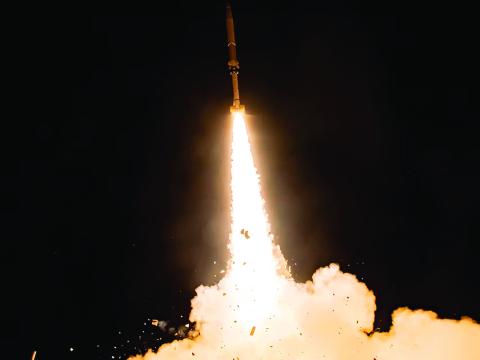Growth of Real Threats Shifts Nation's Space Strategy
Growing threats to national security in the space domain have prompted U.S. Air Force leaders to revamp plans and programs to adapt to a new reality of reinforcing system and network resiliency and shifting its people and resources to focus on warfighting functions. Government space capabilities, augmented by commercial systems, will play critical and active roles to secure U.S. and allied interests in and through the increasingly contested domain of space, requiring the Air Force and the Defense Department to proactively plan how to enable more coordinated and integrated space enterprise operations.
How can the Defense Department and the Air Force manage this new reality? For starters, Air Force leadership must look to the combined strengths of space capabilities provided by both government and industry, which together can assure uninterrupted and resilient communications, navigation, intelligence gathering and warfighting capabilities for U.S. and allied military forces around the globe. The Air Force must look beyond just government-owned resources and solutions and capitalize on commercial capabilities to bolster architecture diversification, proliferation and survivability to sustain space dominance. An architecture is more resilient if it can support mission success with higher probability, shorter periods of reduced capability and across a wider range of scenarios and threats, according to a 2011 Defense Department National Security Space Strategy document.
One way forward is for the Air Force to focus on the roles it must manage and consider delegating others to trusted, forward-thinking commercial partners. This will require more creative thinking that will challenge, or even replace, the status quo. For example, private industry can provide satellite flight and ground network services to augment and reinforce U.S. government capabilities. Commercial satellite operators, such as Intelsat General, fully endorse efforts set by the Air Force’s Space and Missile Systems Center (SMC) to pursue commercialization of Wideband Global Satellite Communications (SATCOM), or WGS, operations as the place to start this new way of doing business.
Concurrently, leaders at the U.S. Strategic Command and Air Force Space Command (AFSPC) are developing concepts, creating plans and defining requirements for a strategy called Fighting SATCOM as a more integrated system of systems—both military and commercial. The Defense Department depends on a SATCOM architecture made up of disparate military and commercial systems managed through a complex array of control arrangements across multiple commands and agencies. That unwieldy situation poses a significant challenge to effective planning and execution of operations in a contested and degraded space environment. Commercial operators, who have provided crucial global military, civil and commercial communications for decades, are ready and willing to help the department overcome that challenge. Today, commercial operators build on that extensive experience and advance new initiatives, such as the Commercial Integration Cell pilot program at the Defense Department’s Joint Space Operations Center, initiated in June 2015 to help the military fulfill robust and resilient space enterprise operations and protect U.S. national security.
Gen. John E. Hyten, USAF, AFSPC commander, supports the endeavor. “[W]e should move WGS satellite bus operations to commercial operators performing satellite control … as soon as possible within contract constraints,” Gen. Hyten wrote in a July 2015 memo to senior subordinates. He recognized the WGS offered “an immediate opportunity” to leverage commercial operations of military satellite constellations, enabling the Air Force and the Defense Department to focus on executing critical functions such as mission payload control—deemed essential for winning current and future conflicts.
Commercialization of WGS constellation on-orbit operations and maintenance would be an effective pathfinder for space enterprise operations. The WGS is built on the same satellite bus family widely operated by industry. Leveraging that experience and adapting business practices would present relatively low transition risk, and transitioning WGS satellite operations to a commercial service provider would pave the way for commercializing other U.S. government space capabilities. In addition, capitalizing on industry capabilities would support Defense Department efforts to realize a new ground system enterprise consisting of common, agile and resilient space and ground infrastructure capabilities. Commercial networks and operations can reinforce U.S. government flexibility in space, bolster the ability to fight threats and enable military personnel to stay focused on battle management. New systems would give military satellite networks a much more flexible, plug-and-play capability and make it far easier to keep up with technological advances. Moving away from custom-built ground systems for each space mission will save a great deal of money while increasing capability and responsiveness to manage the challenges of the growing threat environment.
Industry providers offer effective and secure solutions to address the growing complexity of national security in the space environment. For example, Intelsat has decades of experience providing satellite operations and ground network support for spacecraft built by every major manufacturer, including more than 10 Boeing-built satellites that are based on the same platform as the WGS. Moreover, Intelsat’s expertise in integrating and operating third-party satellites within its ecosystem would enable a smooth and incremental transition to commercialized WGS operations. The capabilities and experience could provide secure, diverse and redundant U.S. satellite operations centers and a worldwide network of commercial telemetry, tracking and control antennas to support Air Force satellite operations. Based on the dynamic needs of the warfighter in a contested environment, commercial operators can deliver highly reliable, resilient and efficient satellite services with extremely high network availability.
While the Defense Department and commercial operators plan for these major steps forward, they must have budgetary support based on new and efficient practices. Fiscal constraints require shifts in strategy and new, highly creative options. The SMC is developing a new method for procuring various commercial satellite resources through a series of pathfinder programs. While the initiatives focus on satellite communication capabilities, they address some of the same budgeting and procurement challenges associated with acquiring commercial satellite services. To achieve space enterprise operations, the Air Force should pursue WGS commercialization, as well as future Satellite Control Network updates, as additional pathfinders that will lead to a more diverse and resilient government and commercial space architecture.
Existing initiatives demonstrate how the Air Force can budget and plan to use commercial space service requirements and accelerate modernizing the service’s ground control network capabilities. Other budgetary alternatives could come from a more intense study and use of best business practices and proven commercial off-the-shelf technology. By thinking differently, Air Force leaders can better use precious fiscal resources to deliver stronger technology before adversaries gain significant superiority over the United States.
The Air Force, together with the commercial satellite industry, can fulfill the goal of strengthening mission operations and transitioning command and control of the WGS sooner rather than later. Gen. Hyten has stated these changes need to happen as soon as possible, hopefully this year. Commercial providers are eager to play key parts in helping to create the defense capabilities that support U.S. national security. By working together, the Defense Department and trusted satellite providers will enhance technological superiority and enable more effective work to resolve any national security crisis.
Rory Welch is director of Space Services for Intelsat General Corp. The views expressed here are his alone.






Comments